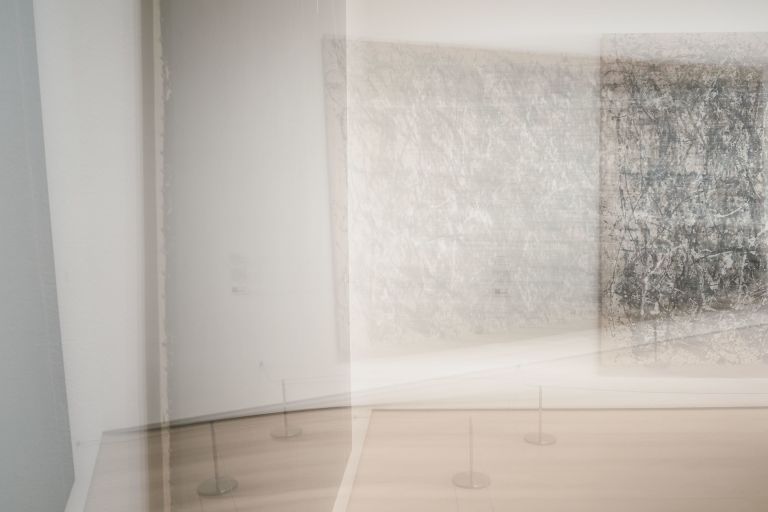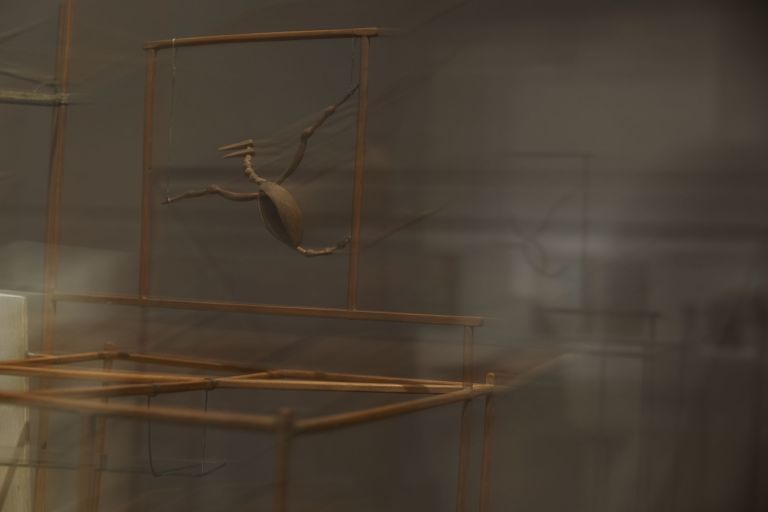Since the early 1980s, Louise Lawler has been making photographic works that focus on the collection and presentation of fine art, and the various meanings of “in-situ.” Her early images were straightforward, black-and-white photographs that documented artworks in museums, auction houses and collector’s homes. Over time the photographs became larger and full of color and, eventually, she used digital tools to manipulate the images. With her work, Lawler creates social commentaries on the juxtapositions she frames, emphasizing the context and relationships between the items on display, as well as the infrastructure and curatorial practices of those exhibiting them.
“GOING THROUGH THE MOTIONS,” Lawler’s current exhibition at Sprüth Magers, begins outside the gallery with a quasi-generic sign placed among the building’s landscaping that reads “Louise Lawler / False Compensation / This Weekend.” The significance of this sign is obtuse until one sees the exhibition inside, which includes photographic works from three of Lawler’s series, “swiped,” “adjusted to fit,” and “traced,” respectively. To create the images that form “swiped,” Lawler moves the camera during long exposures to create a partial blur effect. The blur is unsettling and disorienting, especially when applied to well-known artworks. The piece 1994-N No.2 and One: Number 31, 1950 (swiped) (all works 2022/2023) features a double exposure of Jackson Pollock’s One: Number 31 hung on a wall adjacent to a semi-transparent and faded depiction of Clifford Still’s 1994-N No.2, both on display at the Museum of Modern Art (MoMA). Similarly, The Palace at 4 a.m.(swiped) is a dark, blurry and shadowy photograph of a fragment of Alberto Giacometti’s iconic sculpture. In Lawler’s image, the blur makes the bird-like creature appear in motion as if taking flight.

Louise Lawler, 1994-N No.2 and One: Number 31, 1950 (swiped), 2022-2023. Courtesy of Sprüth Magers.
Covering several of the huge gallery walls are pieces from Lawler’s “adjusted to fit” series. For these works, Lawler instructed each exhibitor to digitally manipulate and re-scale the original images to match the width and height of a given wall. Works like Vir Heroicus Sublimis and Abraham (swiped) (adjusted to fit), and It Spins (adjusted to fit) are distorted beyond recognition and fused onto their respective walls.
In the upstairs of the gallery, Lawler again presents large-scale images, those these are tracings of Lawler’s photographs which simplify the spaces and images contained within into lines. These tracings beg the question: what does a trace reveal or leave out? Moreover, why turn something seemingly objective into something subjective and gestural? Some of the works—like Damien Hirst’s severed goats in Dots and Slices (traced), Jeff Koon’s balloon dog in Egg and Gun (traced) and Felix Gonzales-Torres light bulbs in Bulbs (traced)— are easily identifiable and allow the viewer to imagine the original. That these works exist as digital files that can be scaled to any dimension is in keeping with the practices of numerous conceptual artists whose works are presented as instructions. (Congruent with Lawler’s practice of re-presenting and re-framing, twelve of her tracing images can be downloaded from MoMA’s website for children to color.)
Although Lawler’s photographic practice appears straightforward, it is always changing as she continually devises new ways to manipulate her subjects. Lawler questions authorship by “swiping” work from others. While these works are not “false compensation” as the signage outside the gallery proclaims, they knowingly and slyly re-present the works of others to become evocative and telling documents of collections and exhibitions.



















0 Comments